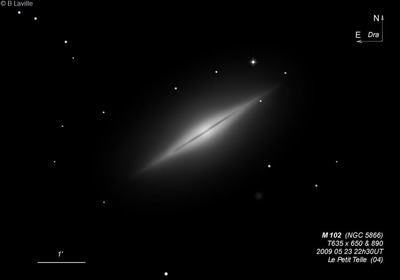
William Herschel discovered NGC 5866 = H I-215 = h1909 on 5 May 1788 (sweep 842) and recorded "vB, cL, E, following 2 stars." His position is poor - nearly 6' southwest of the galaxy. NGC 5866 is likely an edge-on S0 galaxy with a dust lane. NGC 5866 was first observed by Lord Rosse on 27 Apr 1848 and described as "A very bright resolvable nebula, but none of the component stars seen distinctly even with a power of a thousand. A perfectly straight and longitudinal division in the direction of the major axis." George Johnstone Stoney's (Lord Rosse's assistant) sketched the galaxy and dust lane on 27 Apr 1849 (plate XXXVII, figure 8, 1850 publication).
This galaxy is sometimes taken as M102 for completeness of the Messier catalogue. Pierre Méchain found M102 on 27 Mar 1781, but in a letter dated 6 May 1783 to Johann Bernoulli, the editor of the Berliner Astronomisches Jahrbuch, he stated M101 and 102 "are nothing but the same nebula, which has been taken for two, by an error in the charts." But in the September 2015 issue of Sky & Tel, Michael Covington argues that Mechain probably did see NGC 5866, along with the adjacent 7th-magnitude star and Messier may have confirmed the observation. See Harold Corwin's notes for a more detailed analysis of M102.
200/250mm - 8" (6/4/83): fairly bright, brighter central bulge, fainter extension.
300/350mm - 13" (6/4/83): very bright, impressive, large bright core, two stars off the NW and SW edges. A mag 7 star is 10' SW.
400/500mm - 17.5" (6/6/86): very bright, fairly large, elongated 2:1 NW-SE, 3.0'x1.5', bulging bright core. This galaxy has a high surface brightness and a mottled surface. Just a hint of the razor-thin dust lane prominent on photographs is visible. A mag 11.5 star is at the NW end 1.6' from the center and a slightly fainter mag 12 star is 1.5' SW. Located 10' NE of mag 7.5 SAO 29401.
600/800mm - 24" (7/6/13): at 200x appeared extremely bright, large, very elongated 3:1 NW-SE, spindle shaped, well concentrated with a blazing oval core. A very thin, low contrast dust lane bisects the galaxy and is most evident along the central bulging core. The outer halo is much fainter and extends ~3.25'x1.25'. A mag 11.3 star is just off the NW flank, 1.6' from center and a mag 12.2 star is off the SW side 1.4' from center. At 322x, NGC 5867 was picked up 1.0' SSE of the mag 12.2 star as a very faint 8" glow, held continuously with averted vision. NGC 5866B, situated 47' E, appeared faint, ~1' in diameter, slightly elongated N-S, very low surface brightness. Seems to have a small slightly brighter central region.
900/1200mm - 48" (4/21/17): at 488x and 697x; spectacular lenticular (S0/a) with a razor-thin dust lane perfectly bisecting the galaxy. Overall the galaxy is extremely bright, very elongated 3:1 NW-SE, roughly 4'x1.35'. The main spindle contains an intensely bright, bulging oval core that is nearly perfectly bisected by an extremely narrow dust lane. The outer portion of the halo has a low surface brightness and increases in size with averted vision. A mag 11.3 star is at the northwest edge of the halo and a mag 12.2 star is just off the southwest side, 1.4' from center. Also a mag 15.5 star is superimposed on the northwest halo [1.6' from center]. NGC 5867, one of the faintest in the NGC, lies 2' SE. SDSS J150631.55+554348.9, an 18th magnitude galaxy, was marginally glimpsed 2.0' SSE of center.
Notes by Steve Gottlieb